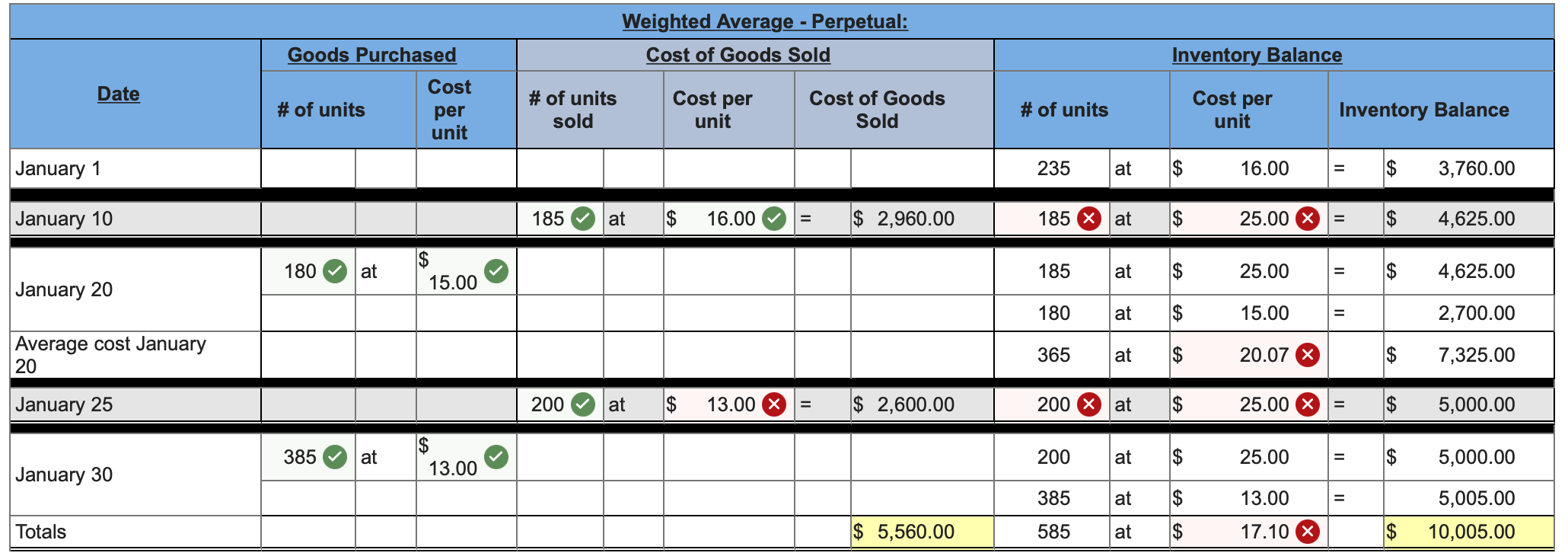Answered step by step
Verified Expert Solution
Question
1 Approved Answer
If you could please show the work, I would greatly appreciate it! Thank you! Laker Company reported the following January purchases and sales data for





If you could please show the work, I would greatly appreciate it! Thank you!
Laker Company reported the following January purchases and sales data for its only product. The Company uses a perpetual inventory system. For specific identification, ending inventory consists of 385 units from the January 30 purchase, 5 units from the January 20 purchase, and 25 units from beginning inventory. Date January 1 January 10 January 20 January 25 January 30 Activities Beginning inventory Sales Purchase Sales Purchase Totals Units Acquired at Cost 235 units @ $ 16.00 = 180 units @ $15.00 = $ 13.00 = 385 units @ 800 units $ 3,760 2,700 5,005 $ 11,465 Units sold at Retail @ 185 units 200 units 385 units @ $ 25.00 $ 25.00 Exercise 6-3 (Algo) Perpetual: Inventory costing methods LO P1 Required: 1. Complete the table to determine the cost assigned to ending inventory and cost of goods sold using specific identification. 2. Determine the cost assigned to ending inventory and to cost of goods sold using weighted average. 3. Determine the cost assigned to ending inventory and to cost of goods sold using FIFO. 4. Determine the cost assigned to ending inventory and to cost of goods sold using LIFO. Date January 1 January 10 January 20 Average cost January 20 January 25 January 30 Totals Goods Purchased # of units 180 at 385 at Cost per unit $ 15.00 13.00 # of units sold 185 200 Weighted Average - Perpetual: Cost of Goods Sold Cost per unit at $ at $ 16.00 13.00 Cost of Goods Sold = $ 2,960.00 $ 2,600.00 $ 5,560.00 # of units 235 185 X at at 185 180 200 x at 200 385 585 Inventory Balance Cost per unit at $ at $ 365 at $ $ $ $ at $ at $ at $ GA 16.00 25.00 X 25.00 15.00 20.07 25.00 25.00 13.00 17.10 X Inventory Balance = $ = || = II $ = $ = $ $ $ 3,760.00 4,625.00 4,625.00 2,700.00 7,325.00 5,000.00 5,000.00 5,005.00 10,005.00 Date January 1 January 10 January 20 Total January 20 January 25 Total January 25 January 30 Totals Goods Purchased # of units Cost per unit # of units sold Perpetual FIFO: Cost of Goods Sold Cost per unit Cost of Goods Sold # of units 235 at Inventory Balance Cost per unit 16.00 = Inventory Balance $ 3,760.00 Date January 1 January 10 January 20 Total January 20 January 25 Total January 25 January 30 Goods Purchased # of units Cost per unit Perpetual LIFO: Cost of Goods Sold # of units sold Cost per unit Cost of Goods Sold # of units 235 at Inventory Balance Cost per unit $ 16.00 Inventory Balance = $ 3,760.00Step by Step Solution
There are 3 Steps involved in it
Step: 1

Get Instant Access to Expert-Tailored Solutions
See step-by-step solutions with expert insights and AI powered tools for academic success
Step: 2

Step: 3

Ace Your Homework with AI
Get the answers you need in no time with our AI-driven, step-by-step assistance
Get Started


